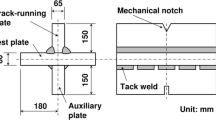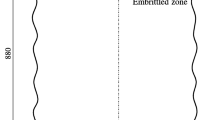Abstract
With demand for ultra-large container ships, high-strength steel plates with extremely large thicknesses are applied to the structural elements around hatch side structures. The two longitudinal plates of the upper deck and hatch side coaming are the main structural elements that support bending stress during hogging of the ship structure, and brittle crack arrest toughness as well as crack initiation toughness are required in these steel plates to avoid the catastrophic ship damage. Although the International Association of Classification Societies prescribes a unified requirement for brittle crack arrest steel plates providing the value of brittle crack arrest toughness Kca at − 10 °C for plate thicknesses of 80 mm or less, ultra-large container ships using steel plates with thicknesses exceeding 80 mm are continuously required and built. In the present work, brittle crack arrest tests with large scale structural model specimens which simulate the structural element of the hatch side structure were performed to investigate the Kca value required to arrest a running brittle crack for steel plates with the thickness of 100 mm. The present investigation suggested that the test plate simulating upper deck could arrest a running brittle crack at the plate Kca of 6000 N/mm3/2, nevertheless the Kca value of 8000 N/mm3/2 was needed in the test plate simulating hatch side coaming. The different Kca values required to arrest a running crack between the test plates simulating the upper deck and the hatch side coaming are also discussed from the viewpoint of the arrested crack size and shape.





















Similar content being viewed by others
References
IACS UR S33 (2015) Requirements for use of extremely thick steel plates, Rev. 1, 2015
The Japan Welding Engineering Society (2014) Test method for brittle crack arrest toughness, Kca, WES 2815, 2014
The International Organization for Standardization (2019) Metallic materials—steel—method of test for the determination of brittle crack arrest toughness, Kca, ISO 20064, 2019
Wiesner CS, Hayes B, Smith SD, Willoughby AA (1994) Investigations into the mechanics of crack arrest in large plate of 1.5% Ni TMCP steel. Fatigue Fract Engng Mater Struct 17:221–233
Yoshiki M, Kanazawa T, Machida S (1963) A consideration on brittle fracture test of steel plate, with special reference to flat-temperature and gradient-temperature type double tension test. J Zosen Kiokai Issue 113:125–135 (in Japanese)
Machida S, Aoki M (1972) Some basic considerations on crack arresters for welded steel structures (The 7th report): with special reference to arrest of an extremely long crack and the design of crack arresters. J Soc Naval Archit Jpn 131:367–378 (in Japanese)
Nishimura M, Matsumoto T, Kitada H, Akiyama H, Nomura D (1997) Safety assessment of hull structure using plates having high crack arrest characteristics. NK Tech Bull 1997:23–30
Kawabata T, Matsumoto K, Ando T, Yajima H, Aihara S, Yoshinari H, Hirota K, Toyoda M, Kiyosue T, Inoue T, Handa T, Tani T (2010) Development of brittle crack arrest toughness Kca test method—Brittle crack arrest design for large container ships-2, Proceeding of the 20th International Offshore and Polar Engineering Conference (ISOPE2010), Beijing, China, June 20–25, 2010, Vol. 4, pp. 80–87
Kubo A, Yajima H, Aihara S, Yoshinari H, Hirota K, Toyoda M, Kiyosue T, Inoue T, Handa T, Kawabata T, Tani T, Yamaguchi Y (2012) Experimental study on brittle crack propagation behavior with large scale structural component model tests—Brittle crack arrest design for large container ships-5, Proceeding of the 22th International Offshore and Polar Engineering Conference (ISOPE2012), Rhodes, Greece, June 17–22, 2012, Vol. 4, pp. 36–43
Handa T, Matsumoto T, Yajima H, Aihara S, Yoshinari H, Hirota K, Toyoda M, Kiyosue T, Inoue T, Kawabata T, Tani T, (2010) Effect of structural discontinuities of welded joints on brittle crack propagation behavior—Brittle crack arrest design for large container ships-3, Proceeding of the 20th International Offshore and Polar Engineering Conference (ISOPE2010), Beijing, China, June 20–25, 2010, Vol. 4, pp. 88–94
Inoue T, Yamaguchi Y, Yajima H, Aihara S, Yoshinari H, Hirota K, Toyoda M, Kiyosue T, Handa T, Kawabata T, Tani T, Required brittle crack arrest toughness Kca value with actual-scale model tests—Brittle crack arrest design for large container ships-4, Proceeding of the 20th International Offshore and Polar Engineering Conference (ISOPE2010), Beijing, China, June 20–25, 2010, Vol. 4, pp. 95–101
Sugimoto K, Yajima H, Aihara S, Yoshinari H, Hirota K, Toyoda M, Kiyosue T, Inoue T, Handa T, Kawabata T, Tani T, Usami A (2012) Thickness effect on the brittle crack arrest toughness value (Kca)—Brittle crack arrest design for large container ships-6, Proceeding of the 22th International Offshore and Polar Engineering Conference (ISOPE2012), Rhodes, Greece, June 17–22, 2012, Vol. 4, pp. 44–51
Yamaguchi Y, Yajima H, Aihara S, Yoshinari H, Hirota K, Toyoda M, Kiyosue T, Tanaka S, Okuda T, Kageyama K, Funatsu Y, Handa T, Kawabata T, Tani T (2010) Development of guidelines on brittle crack arrest design—Brittle crack arrest design for large container ships-1, Proceeding of the 20th International Offshore and Polar Engineering Conference (ISOPE2010), Beijing, China, June 20–25, 2010, Vol. 4, pp. 71–79
ClassNK (2009) Guidelines on brittle crack arrest design
Handa T, Igi S, Endo S, Tsuyama S, Shiomi H (2013) Effect of distance of loading points on long brittle crack propagation/arrest behavior. Sci Technol Weld Join 18:478–484
Handa T, Toyoda M, Kiji N, Inose K, Watanabe S, Shiomi H, Igi S, Oi K (2015) Effect of fillet weld metal toughness on long brittle crack arrest behavior in tee joint, Proceeding of the 25th International Offshore and Polar Engineering Conference (ISOPE2015), Kona, Hawaii, USA, June 21–26, 2015, Vol. 4, pp. 135–140
Shibanuma K, Yanagimoto F, Namegawa T, Suzuki K, Aihara S (2016) Brittle crack propagation/arrest behavior in steel plate. Part I: model formation. Engng Fract Mech 162:324–340
Shibanuma K, Yanagimoto F, Namegawa T, Suzuki K, Aihara S (2016) Brittle crack propagation/arrest behavior in steel plate. Part II: experiments and model validation. Engng Fract Mech 162:341–360
Shibanuma K, Yanagimoto F, Suzuki K, Aihara S (2018) brittle crack propagation/arrest behavior in steel plate. Part III: discussion on arrest design. Engng Fract Mech 190:104–119
Mirakami Y (Ed.) (1987) Stress intensity factors handbook, Pergamon Press, Vol. 2, pp. 712–715
Hiramatsu H, Matsuda H, Michiba K, Nishioka G, Kiyosue T, Matsuura M, Okamoto K, Kawabata T, Maeda T, Inami A, Kubo S (2007) Investigation on the brittle crack propagation behavior of heavy thick shipbuilding steel plates, Report 1: The crack arrestability of brittle crack propagation in the thickness direction in steel plate, Proceedings of the annual meeting in the Japan Society of the Naval Architectures and Ocean Engineers (2007), Paper#: 2007E-G5-2. (in Japanese)
Nishimura K, Takeuchi Y (2014) Mechanical properties distribution through the thickness of heavy gauge steel plate rolled in intercritical region. Tetsu Hagane 100:1097–1103 (in Japanese)
Acknowledgements
The present work was achieved on the platform of the Japan Welding Engineering Society (JWES). A joint industrial research committee named the ATE3 (3rd phase Arrest Toughness Evaluation) Committee was organized with the participation of ClassNK, steel manufacturers, shipbuilding companies and universities in Japan. Here, the authors gratefully acknowledge the contribution of all the committee members and express their thanks to all those concerned for their appropriate advices in the test planning and fruitful discussions of the test results.
Author information
Authors and Affiliations
Corresponding author
Additional information
Publisher's Note
Springer Nature remains neutral with regard to jurisdictional claims in published maps and institutional affiliations.
Appendix
Appendix
Additional photographs of the tested specimens are shown in Figs. 22, 23, 24. The figure numbers in Appendix are referred in the main text.
Photographs of specimen after brittle crack arrest test (Test 2-4). a Bottom view of t/4 (25 mm) groove depth side. b Bottom view of t/3 (33 mm) groove depth side. c Magnified image of white square (c) in a. d Magnified image of white square (d) in b. Where t means the total plate thickness of 100 mm
About this article
Cite this article
Tagawa, T., Tajika, H., Handa, T. et al. An experimental study on Kca value to arrest a running brittle crack in structural model specimens with steel plate of 100 mm thickness for container ships. J Mar Sci Technol 25, 943–963 (2020). https://doi.org/10.1007/s00773-019-00692-7
Received:
Accepted:
Published:
Issue Date:
DOI: https://doi.org/10.1007/s00773-019-00692-7







